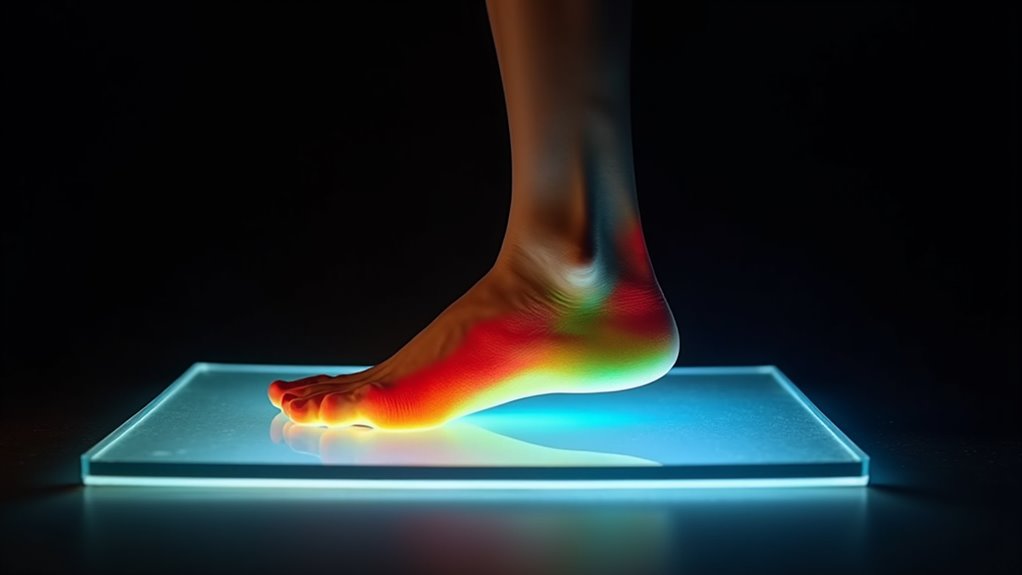There may be products. Products are independently selected by our editors. We may earn an affiliate commission from the links with no charge to you, example: as Amazon Affiliate.
When you’re walking, you’re actually participating in a complex symphony of pressure shifts that most people never consider. Your feet endure forces of up to several times your body weight with each step, orchestrating a precise sequence of weight transfers from heel strike through toe-off. While this process happens automatically, understanding the science of pressure distribution can help you prevent injuries, improve athletic performance, and make better choices about footwear. There’s much more to the way your feet interact with the ground than meets the eye, and the implications affect everything from your daily comfort to your athletic achievements.
Key Takeaways
- Peak pressures concentrate under the heel during initial contact, then transfer through the midfoot to metatarsal heads during walking.
- The foot’s arch system facilitates smooth weight transfer from heel strike to push-off while maintaining stability throughout stance.
- Pressure patterns vary by individual factors like age, BMI, and foot structure, affecting how force distributes from heel to toes.
- During push-off, the hallux (great toe) experiences significant pressure and plays a crucial role in forward propulsion.
- Advanced measurement tools can map precise pressure transitions from heel to toe using up to 256 sensor points.
Understanding Plantar Pressure Basics
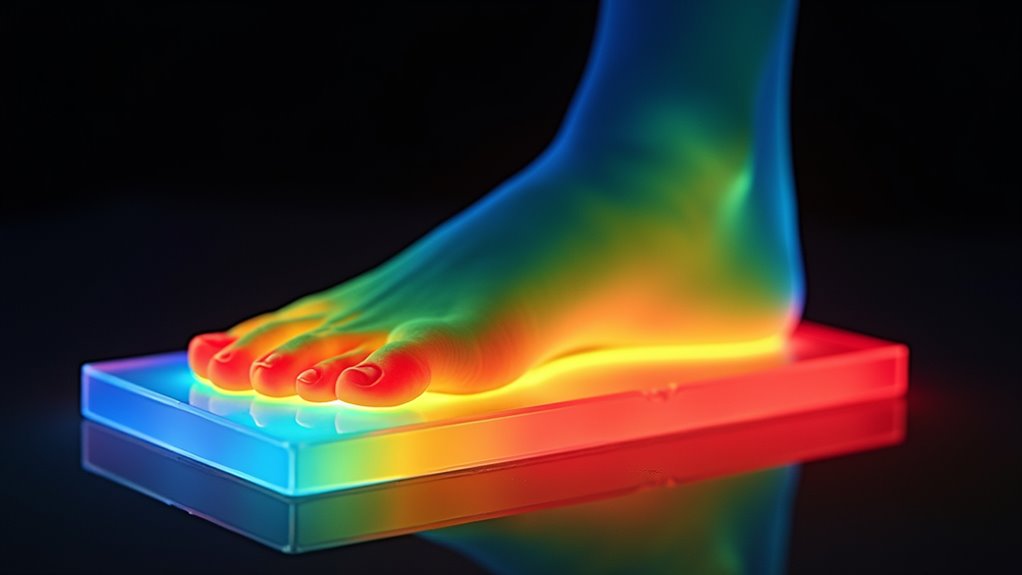
When you analyze plantar pressure distribution, you’re examining how weight and force spread across different regions of your foot.
Your foot’s pressure patterns vary significantly between areas like the forefoot, hallux, metatarsals, midfoot, and heel, with peak pressures typically occurring under your second and third metatarsal heads, great toe, and heel.
Your age, gender, and BMI directly influence how pressure distributes across your feet.
The shoes you wear and activities you perform also change these patterns. Whether you’re walking or running, your foot experiences different pressure points that clinicians can measure both statically and dynamically.
Understanding these pressure variations is crucial because they can signal potential foot problems or injuries, helping healthcare providers develop targeted prevention strategies and treatment plans.
Measurement Tools and Systems
You’ll find two main categories of tools for measuring heel-to-toe pressure distribution: in-shoe sensors that track pressure while walking and platform-based systems that capture data as you step across them.
Modern in-shoe technology includes ultra-thin sensors and wireless systems that let you move naturally while collecting precise pressure readings throughout your gait cycle.
Platform innovations have evolved to include high-resolution sensor arrays and real-time data recording capabilities, giving you comprehensive insights into your foot mechanics and pressure patterns.
In-Shoe Sensor Technology
Modern in-shoe sensor technology represents a breakthrough in pressure distribution measurement, combining sophisticated sensing elements with wireless connectivity.
You’ll find these systems use capacitive sensors, resistive textiles, and conductive yarns integrated seamlessly into footwear or insoles, ensuring natural foot motion isn’t compromised.
The technology delivers impressive specifications, with up to 256 measuring points and sampling frequencies reaching 100 Hz.
You’re getting real-time data transmission through Bluetooth or Wi-Fi to your computer or smartphone, where specialized software like Chameleon and VisuPress analyzes the results.
These portable systems excel in various applications – from clinical gait analysis to athletic performance optimization.
Whether you’re evaluating footwear designs or diagnosing foot pathologies, you’ll benefit from the high sensitivity and reliability these sensors provide.
Platform Device Innovations
Platform device innovations complement in-shoe sensors with advanced pressure mapping technologies. TactArray and Tekscan systems offer flexible, high-resolution solutions that capture detailed pressure distribution data between surfaces. These platforms integrate seamlessly with state-of-the-art visualization software for real-time analysis and comprehensive research applications.
- Continuous pressure sensing sheets provide 2D arrays with multiple sensing elements for precise measurement.
- Advanced visualization software enables intuitive data interpretation with vivid graphics.
- Wireless interfaces and Bluetooth connectivity allow for unrestricted movement during testing.
- Video recording integration enhances analysis by correlating pressure data with actual motion.
You’ll find these platforms particularly valuable for clinical studies, gait analysis, and orthotic design.
The systems’ ability to measure both static and dynamic events with minimal interference makes them essential tools for understanding pressure distribution patterns.
Advanced Data Recording Systems
Advanced data recording systems have revolutionized foot pressure analysis through sophisticated sensor technologies and seamless data integration.
You’ll find these systems equipped with high-frequency data capture capabilities, recording up to 128 samples per second, and offering extensive storage capacity of up to 64 GB.
The systems connect wirelessly to your devices via Wi-Fi or Bluetooth, allowing you to monitor pressure distributions in real-time. You can easily export this data for detailed analysis using specialized software like the Chameleon Visualization tool.
Whether you’re conducting sports medicine research or developing new footwear, these recording systems let you track pressure patterns across multiple foot areas simultaneously.
They’re compatible with various sensor configurations, including in-shoe systems and focused measurement pads, giving you comprehensive insights into plantar pressure dynamics.
Key Impact Zones
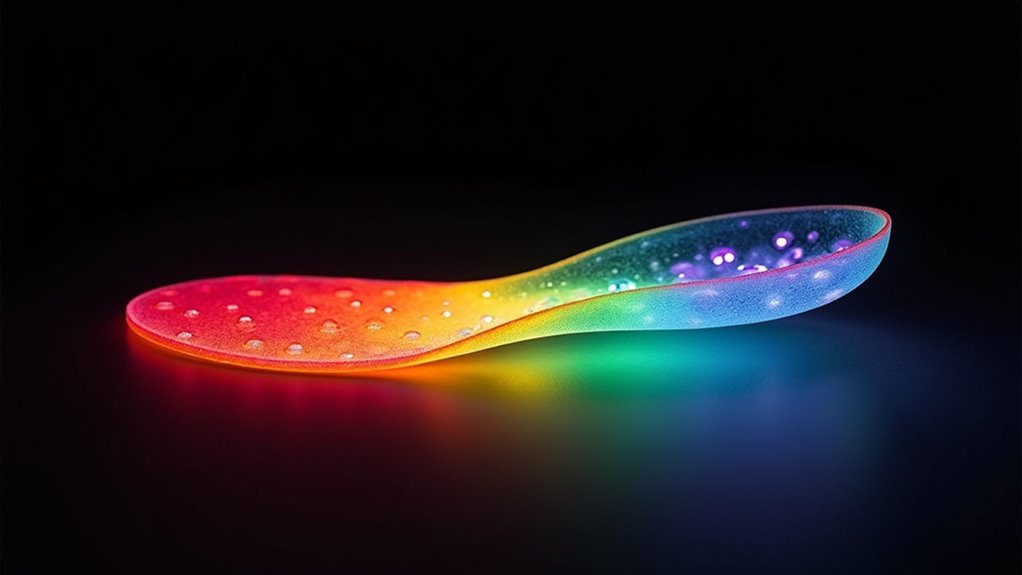
When you examine foot pressure patterns, you’ll notice distinct loading zones from heel strike through midfoot to forefoot push-off.
Your heel experiences initial impact forces during strike, while your midfoot arch manages weight transfer and stability throughout stance.
Your forefoot and toes then take on significant pressure during the final push-off phase, with the metatarsal heads bearing much of this load.
Medical comfort heels can help redistribute these pressure patterns more evenly across your foot.
Heel Strike Loading Patterns
During initial ground contact, heel strike creates distinct loading patterns that significantly influence the body’s biomechanics. Your foot experiences complex muscle activations and force distributions, particularly at the moment of impact when your heel first touches the ground.
- Your knee undergoes a 10-15° flexion with eccentric extensor activity while ground reaction forces travel anterior to the joint.
- Your ankle maintains a neutral position (0° dorsiflexion) as dorsiflexors contract eccentrically.
- Your hip muscles work in tandem, with extensors contracting concentrically while flexors work eccentrically.
- Your ground reaction forces shift from heel to forefoot, affecting overall pressure distribution.
These loading patterns can change dramatically with footwear choices or conditions like Parkinson’s disease, where you’ll see reduced heel impact and altered forefoot loading.
Midfoot Pressure Distribution
Throughout daily activities, your midfoot region experiences distinct pressure patterns that vary significantly based on movement type and footwear choices. You’ll notice lower pressure in your midfoot compared to your forefoot and heel during dynamic activities like jumping and running. Your shoe’s sole shape directly impacts these pressure distributions, which is particularly important if you’re managing diabetic foot conditions.
| Activity | Midfoot Pressure | Clinical Significance |
|---|---|---|
| Standing | Moderate | Arch support assessment |
| Walking | Variable | Gait analysis |
| Running | Low | Impact distribution |
| Jumping | Minimal | Force absorption |
Modern pressure measurement tools like Tekscan HR mats and integrated footwear sensors help track your midfoot pressures accurately. This data’s crucial for identifying potential issues and designing appropriate footwear that can help prevent pressure-related complications, especially if you’re at risk for diabetic foot ulcers.
Forefoot Push-Off Forces
As you generate forward momentum, your forefoot experiences significant forces during push-off, with the first ray and hallux bearing the greatest impact. Your forefoot’s role becomes even more crucial during explosive movements and faster walking speeds, where the hallux significantly contributes to force production and stability.
- Your ankle and MTP joints work in opposite directions during push-off, optimizing force transfer to the front of your foot.
- Your arch’s natural mobility helps distribute forces effectively – restricting it forces other joints to compensate.
- Your first ray and big toe become increasingly important as you walk faster or move uphill.
- Your plantar pressure peaks in the forefoot during dynamic activities, highlighting its critical role in force management.
You’ll notice varying pressure patterns across different forefoot areas, with the hallux showing the most substantial contribution during the final push-off phase.
Clinical Research and Applications
While clinical research continues to expand our understanding of heel-to-toe pressure distribution, numerous studies have revealed critical insights into various medical conditions.
You’ll find that patients with juvenile rheumatoid arthritis show higher peak pressures compared to typical children, while those with Parkinson’s disease display reduced heel strike impact and increased forefoot loading.
Diabetic patients typically experience their highest pressures in the central forefoot region.
Today’s advanced measurement tools, like the Tekscan HR mat and EMED-F system, help clinicians diagnose and treat these conditions more effectively.
You can use these findings to develop targeted treatment strategies, prevent complications like diabetic ulcers, and improve rehabilitation outcomes.
This research has proven invaluable in understanding gait abnormalities and optimizing foot function across different patient populations.
Footwear Design Implications
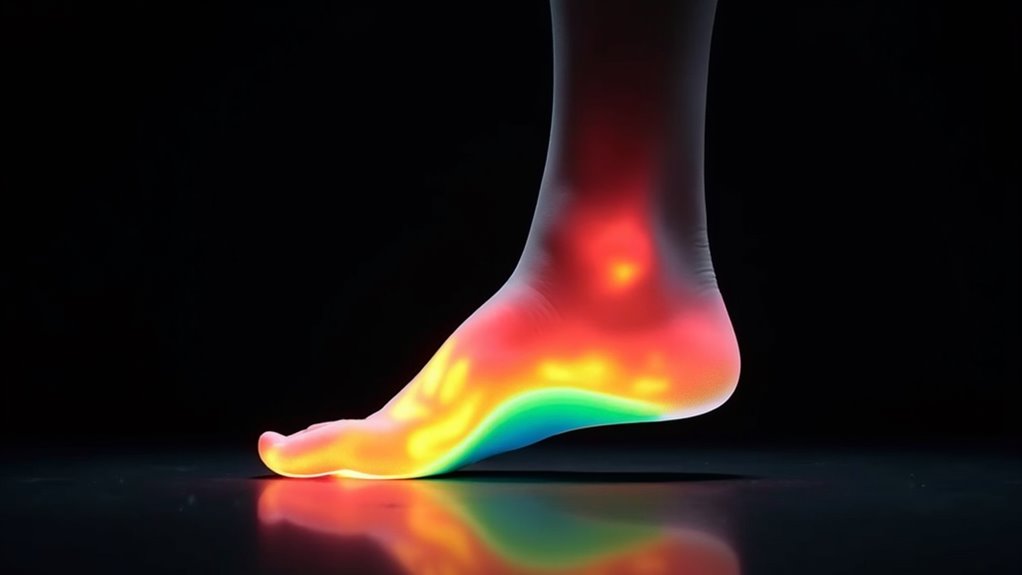
Modern footwear design relies heavily on pressure distribution data to create effective and comfortable shoes.
You’ll find that rocker sole designs can reduce pressure by up to 65% under the heel and central metatarsal heads, while adjustable profiles allow for customized pressure relief in specific foot areas.
- Custom-made shoes with plaster cast-based designs provide tailored pressure relief
- EVA insoles specifically target posteromedial heel pressure reduction
- Higher apex angles help relieve pressure in the hallux region
- Lower apex settings effectively manage lateral forefoot pressure
When designing footwear, you’ll need to consider that increasing total contact area doesn’t significantly reduce forefoot pressure.
Instead, focus on specific rocker profiles and apex settings to achieve targeted pressure relief.
The standardization of rocker profile shapes ensures consistent results across mass-produced shoes.
Movement and Pressure Patterns
Understanding gait variations reveals significant changes in heel-to-toe pressure distribution patterns.
When you shuffle, you’ll notice reduced peak pressures by up to 63% compared to normal walking, especially at your first and second metatarsals and hallux.
Your foot-to-floor contact time increases by nearly 77%.
Your foot type significantly impacts how pressure distributes.
If you have flat feet, you’ll experience lower forces in your lateral forefoot, which may protect you from certain stress fractures.
When your foot’s sensory perception is reduced, you’ll shift load from your heel and toes toward the central and lateral areas.
During walking, you’ll typically show one of three pressure patterns: highest pressure under your first metatarsal, under your second and third metatarsals, or distributed across multiple metatarsal heads.
For evening events, rainbow effect heels can alter your natural pressure distribution while adding visual appeal to your footwear.
Biomechanical Assessment Methods
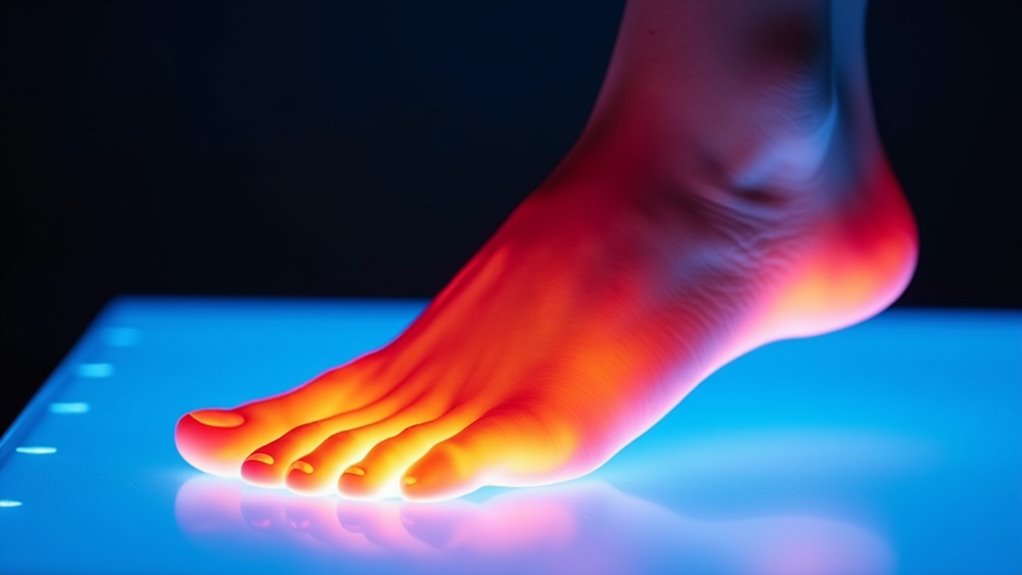
To accurately measure these pressure distribution patterns, researchers and clinicians rely on sophisticated biomechanical assessment tools. You’ll find force plates and pressure mapping systems at the heart of these assessments, providing detailed data about how your feet interact with the ground.
In-shoe sensor systems offer wireless measurements during daily activities, while rigid pressure platforms deliver precise plantar pressure readings.
- Force plates capture vertical ground reaction forces and center of pressure data
- Pressure distribution sensors create dynamic maps of foot movement patterns
- In-shoe systems monitor real-time pressure changes during various activities
- Tekscan’s specialized systems analyze detailed foot function and gait patterns
These tools help professionals understand your unique foot mechanics, assess pathologies, and design effective interventions like custom orthotics and footwear modifications.
Factors Affecting Pressure Distribution
Various factors significantly influence the heel-to-toe pressure distribution in your feet, ranging from medical conditions like diabetes to age-related changes and external footwear choices.
If you have diabetic neuropathy, you’ll likely experience increased plantar pressures, especially under your forefoot and rearfoot. This condition, combined with limited joint mobility and foot deformities, raises your risk of ulcers.
As you age, you’ll notice changes in foot mechanics due to increased soft tissue stiffness and decreased range of motion, often leading to a more pronated posture.
Your footwear choices matter too. High heels shift pressure from your rearfoot to forefoot, while proper orthotics can help redistribute these forces.
Your heel strike naturally produces higher peak pressures than push-off phases, but you can modify these patterns through gait training devices and appropriate footwear. Consider choosing eco-friendly shoes that provide proper support while minimizing environmental impact.
Conclusion
Just when you think you’ve mastered the complexities of heel-to-toe pressure distribution, you’ll discover there’s always more to learn. You’re now equipped with crucial knowledge about plantar mechanics, but the field keeps evolving. Whether you’re designing footwear or treating patients, remember: every step reveals new patterns. It’s up to you to stay current with emerging research and technologies that’ll revolutionize how we understand foot pressure dynamics.

